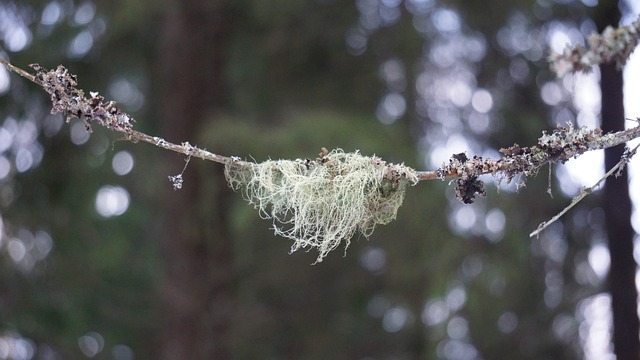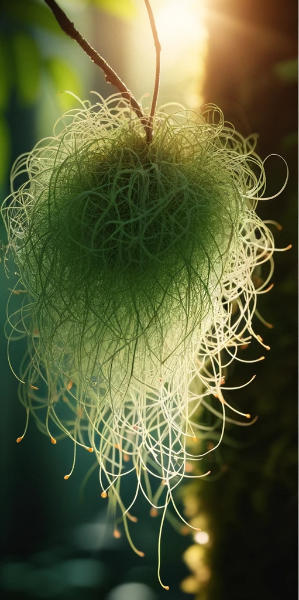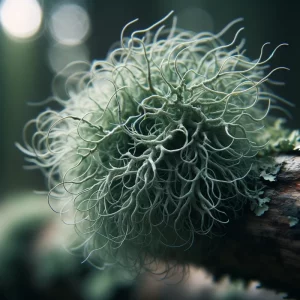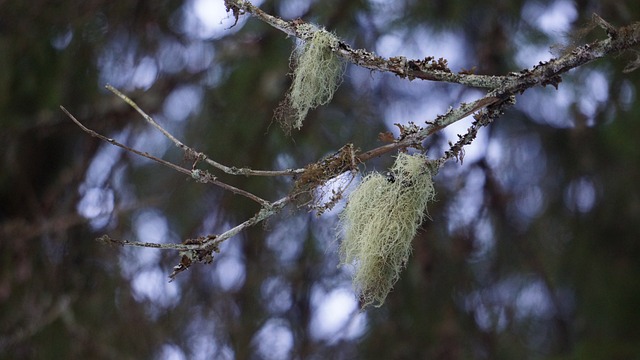Usnea Benefits and Uses – invites you into a world where ancient wisdom meets modern science. Usnea, a seemingly humble lichen clinging to tree branches, is a powerhouse of natural remedies and applications, a treasure trove waiting to be explored. This article delves into the multifaceted benefits and diverse uses of Usnea, shedding light on its potential in both traditional and contemporary medicine. From its remarkable antimicrobial properties to its role in skincare and beyond, we journey through the world of Usnea, uncovering its secrets and understanding why this natural wonder is gaining attention for health and wellness. Join us in exploring the myriad benefits and uses of Usnea, and discover how this ancient organism could have a significant impact on modern health practices.
Usnea Identification and Harvesting
Identification of Usnea:
- Appearance: Usnea, often called ‘Old Man’s Beard,’ is a fruticose lichen that resembles a tangled mass of fibers. It’s typically gray or greenish in color, hanging from tree branches like hair.
- Texture: Usnea is unique in its texture; it’s stretchy when pulled apart, a key feature distinguishing it from similar-looking lichens.
- Habitat: It predominantly grows on the branches of trees in humid, clean-air environments, often found in forests, especially in areas away from urban pollution.
- Test: A definitive test for Usnea is the ‘stretch test.’ The central cord stretches when you gently pull a strand, unlike similar lichens.
Harvesting Usnea:
- Sustainable Practices: Harvest responsibly. Usnea grows slowly, so take only what you need, ensuring enough lichen remains to promote regrowth.
- Healthy Trees: Harvest from fallen branches or dead trees when possible. Avoid overharvesting from living trees, as it can damage the host.
- Collection Method: Gently hand-pick the lichen. Using tools can damage both the lichen and the tree. Collect from various trees rather than depleting one area.
- Clean Harvest: Ensure the Usnea is free from pollutants. Avoid areas near roads or industrial sites where it can accumulate toxins.
- Post-Harvest: Once collected, clean the Usnea by gently shaking to remove any debris. Avoid washing with water as it can lead to mold during drying.
Drying and Storage:
- Drying Process: Dry Usnea in a well-ventilated, shaded area. Sunlight can degrade its medicinal properties. Ensure it’s completely dry to prevent mold.
- Storage: Once dry, store Usnea in a cool, dark place in an airtight container. Properly stored, it can be preserved for several years.
Ethical Considerations:
- Respect Nature: Always forage with respect for the environment. Understand the ecosystem and its balance.
- Legal Compliance: Be aware of local regulations regarding foraging. Some areas may have restrictions or require permits.
By following these guidelines, foragers can responsibly and effectively harvest Usnea, tapping into its valuable medicinal and health properties. Remember, responsible harvesting ensures the sustainability of Usnea and respects the delicate balance of the ecosystems where it thrives.

Chemical Composition and Active Constituents
Chemical Composition of Usnea:
- Usnic Acid: The most notable constituent of Usnea is usnic acid. This compound is primarily responsible for the lichen’s potent antimicrobial and antifungal properties.
- Polyphenols: Usnea is rich in polyphenols, which are known for their antioxidant activity. These compounds play a crucial role in protecting the body against oxidative stress and may support overall health.
- Polysaccharides: Usnea contains beneficial polysaccharides that have been shown to support immune system function. These complex sugars can have a modulating effect on the immune response.
Active Constituents and Their Properties:
- Antimicrobial Activity: Usnic acid is highly effective against a broad spectrum of bacteria and fungi. This makes Usnea a valuable natural remedy for treating bacterial and fungal infections.
- Anti-inflammatory Effects: Some constituents in Usnea exhibit anti-inflammatory properties, which can be beneficial in treating various inflammatory conditions.
- Antioxidant Properties: The polyphenols in Usnea help neutralize harmful free radicals, potentially reducing the risk of certain chronic diseases.
Pharmacological Aspects:
- Usnic Acid as a Bioactive Compound: It has been the subject of extensive research due to its bioactive potential. Usnic acid has demonstrated various pharmacological activities, including antiviral, antibacterial, antifungal, and anticancer properties. https://pubmed.ncbi.nlm.nih.gov/36364296/
- Potential Therapeutic Uses: Given its broad range of activities, Usnea and its constituents are being explored for potential therapeutic applications in treating infections, chronic inflammations, and even certain types of cancer. https://pubmed.ncbi.nlm.nih.gov/30151647/
Safety and Toxicity Concerns:
- Dose-Dependent Effects: While Usnea has many beneficial properties, it is important to use it judiciously. Usnic acid, in particular, can be hepatotoxic in high doses or prolonged use. https://pubmed.ncbi.nlm.nih.gov/32961280/
- Importance of Proper Identification: Accurate identification of Usnea is crucial, as some other lichens may contain different compounds with varying effects and potential toxicities.
Usnea’s unique composition makes it a valuable resource in natural medicine, but it’s essential to approach its use with an understanding of its complex chemistry and potential safety concerns. By harnessing its active constituents judiciously, we can effectively utilize Usnea for its therapeutic benefits while respecting its potency and potential risks.
Usnea Benefits for Health
Usnea has been used for centuries for its health benefits. Here is a list of the current understanding of the Usnea benefits for health.
Antimicrobial Properties:
- Broad-Spectrum Antibacterial Activity: Usnea is renowned for its potent antibacterial properties, primarily due to the presence of usnic acid. This compound is effective against a range of pathogenic bacteria, making Usnea a valuable natural remedy for bacterial infections. https://pubmed.ncbi.nlm.nih.gov/33583797/
- Antifungal Benefits: Usnea also exhibits significant antifungal activity, which can be particularly beneficial in treating skin and nail fungal infections, such as athlete’s foot or ringworm. https://pubmed.ncbi.nlm.nih.gov/35009036/
Respiratory Health:
- Supporting Respiratory Function: Usnea has been traditionally used to support respiratory health. Its antimicrobial properties can help in the management of respiratory infections. https://nittygrittylife.com/usnea-lungs-forest/
- Soothing Inflammation: The lichen may also help soothe inflammation in the respiratory tract, which is beneficial in conditions like bronchitis or sore throat.
Immune System Support:
- Immune Modulation: The polysaccharides found in Usnea can help modulate the immune system. This makes Usnea a potential natural aid in boosting the body’s defense mechanisms against various pathogens.
- Enhancing Immune Response: Regular use of Usnea, in controlled amounts, might enhance the body’s natural immune response, helping to ward off infections.
Skin Health and Wound Healing:
- Topical Application for Skin Health: Usnea can be applied topically in the form of salves or tinctures for skin health. Its antimicrobial properties help in treating minor cuts, burns, and skin infections.
- Accelerating Wound Healing: The lichen may also accelerate the healing process of wounds due to its anti-inflammatory and antimicrobial properties. https://pubmed.ncbi.nlm.nih.gov/15981883/
Anti-inflammatory Effects:
- Reducing Inflammation: Usnea contains compounds that exhibit anti-inflammatory properties, making it beneficial in reducing inflammation in various conditions, including skin irritations and internal inflammation. https://pubmed.ncbi.nlm.nih.gov/16194053/
Antioxidant Activity:
- Combatting Oxidative Stress: The presence of antioxidants in Usnea helps in neutralizing harmful free radicals, potentially reducing the risk of chronic diseases related to oxidative stress. https://pubmed.ncbi.nlm.nih.gov/25885942/
Safety and Precautions:
- Awareness of Potential Toxicity: While Usnea offers numerous health benefits, it’s important to be aware of its potential toxicity, particularly in liver health, when consumed in large quantities or over extended periods.
- Consultation with Healthcare Providers: Individuals should consult healthcare professionals before using Usnea, especially those with pre-existing health conditions or those taking other medications.

Usnea Benefits in Traditional and Contemporary Uses
Usnea, a lichen found in many parts of the world, holds a significant place in both traditional and contemporary medicinal practices due to its remarkable health benefits. Traditionally, Usnea has been used for centuries in various cultures for its healing properties. It was commonly used by indigenous peoples to treat wounds and infections, thanks to its potent antimicrobial properties. In traditional Chinese medicine, Usnea, known as “Songluo,” was utilized to clear heat and release toxins from the body, reflecting its antibacterial and antiviral capabilities.
In contemporary medicinal uses, Usnea continues to be valued for its strong antibacterial and antifungal properties, primarily attributed to the presence of usnic acid. This compound is effective against a broad spectrum of bacteria and fungi, making Usnea a valuable natural remedy for bacterial and fungal infections, particularly those affecting the skin and mucous membranes. The lichen is often prepared as a tincture or salve and applied topically to treat minor wounds, skin infections, and fungal conditions like athlete’s foot.
Usnea’s benefits extend beyond its antimicrobial action. In modern herbal medicine, it is increasingly recognized for its potential to support respiratory health. Due to its expectorant properties, Usnea is used in cough formulas and remedies for bronchial infections. It helps in loosening phlegm and easing coughs, making it a valuable component in treating colds and respiratory ailments.
The lichen also exhibits anti-inflammatory properties, making it beneficial in reducing inflammation in various conditions. This aspect of Usnea is particularly useful in treating conditions like sore throat and inflamed mucous membranes. Additionally, its antioxidant properties contribute to its role in overall wellness, helping to neutralize harmful free radicals in the body.
In terms of preparation, Usnea is often used in the form of teas, tinctures, and extracts. The preparation method depends on the intended use; for instance, tinctures are commonly used for internal ailments, while salves and poultices are preferred for topical applications. The adaptability of Usnea in various forms makes it a versatile remedy in both traditional and modern herbal practices.
Despite its numerous benefits, it’s important to approach the use of Usnea with caution, particularly regarding dosage and duration of use. Usnic acid, while beneficial, can be hepatotoxic in high doses or with prolonged use. Therefore, consulting with healthcare professionals or experienced herbalists before using Usnea, especially for internal use, is advisable.
Usnea in Research and Modern Medicine
Usnea, a lichen that has long been used in traditional medicine, is now gaining significant attention in the realm of modern medical research. This interest is primarily driven by Usnea’s unique chemical composition, particularly the presence of usnic acid, which has shown promising therapeutic properties.
In recent years, scientific studies have focused on the antimicrobial properties of Usnea, especially its effectiveness against bacteria and fungi. This has led to the exploration of Usnea as a potential source for developing new antibiotics, a field of great interest in an era where antibiotic resistance is a growing concern. Research has demonstrated that usnic acid, the primary active compound in Usnea, is effective against a variety of pathogens, including those resistant to conventional antibiotics.
Beyond its antimicrobial capabilities, Usnea is being investigated for its potential in cancer research. Preliminary studies suggest that certain compounds in Usnea may inhibit the growth of cancer cells. This area of research is still in its infancy, but it opens the door to the possibility of Usnea-based treatments or adjunct therapies in oncology.
Usnea’s anti-inflammatory properties are another area of interest in modern medicine. Chronic inflammation is a known contributor to many diseases, and the anti-inflammatory compounds in Usnea could offer new avenues for treatment. Researchers are exploring how these properties can be harnessed to treat conditions like arthritis, inflammatory skin disorders, and other inflammatory diseases.
The lichen’s antioxidant properties are also noteworthy. Antioxidants play a crucial role in neutralizing free radicals, which can cause oxidative stress and contribute to chronic diseases. The study of Usnea’s antioxidant components could lead to developments in preventing or managing conditions related to oxidative stress, such as heart disease and certain neurological disorders.
Importantly, modern research is also delving into the safety and efficacy of Usnea. While traditional use provides a basis for its benefits, rigorous scientific studies are necessary to understand optimal dosages, potential side effects, and interactions with other medications. This is particularly crucial given concerns over the hepatotoxicity of usnic acid when used inappropriately.
Despite the promise Usnea shows in research and modern medicine, it’s important to approach its use with a blend of traditional wisdom and scientific understanding. As research continues to uncover the potential of Usnea in various medical applications, it stands as an excellent example of how natural sources can contribute to modern healthcare solutions. This ongoing research not only validates many traditional uses of Usnea but also paves the way for new, innovative treatments derived from this ancient lichen.

Usnea Benefits in Other Industries
Usnea extends its utility beyond medicinal applications, finding its place in various industries owing to its unique properties. One of the notable non-medicinal uses of Usnea is in the cosmetics and skincare industry. Its antimicrobial and anti-inflammatory properties make it an ideal ingredient in products aimed at skin health. Usnea extracts are increasingly being incorporated into creams, lotions, and serums, particularly those targeting acne, eczema, and other skin conditions that benefit from its soothing and healing effects. The lichen’s ability to combat bacteria and fungi is especially valuable in products designed for sensitive or problematic skin.
Another interesting application of Usnea is in the textile and dyeing industry. Historically, Usnea has been used as a source of natural dye. The lichen yields a range of colors, from yellows to oranges and greens, depending on the extraction process and mordants used. This natural dye is valued for its eco-friendly aspect and is used in artisanal textile production. In an era where sustainable and environmentally friendly practices are gaining importance, the use of natural dyes like those derived from Usnea is seeing a resurgence.
Usnea also finds its place in the food industry, albeit to a lesser extent. Its antimicrobial properties can be harnessed as a natural preservative in certain food products. While its use in mainstream food processing is limited, there is potential for Usnea to be explored as a natural alternative to synthetic preservatives, especially in organic and health-focused food products.
Additionally, Usnea’s ability to absorb and neutralize certain substances has led to its exploration in environmental applications. It is being studied for use in bio-monitoring, particularly in assessing air quality and pollution levels. Usnea’s sensitivity to air pollutants makes it an effective natural indicator of environmental health, providing valuable data for ecological and environmental studies.
Conclusion
The exploration of Usnea, a humble yet potent lichen, reveals a remarkable spectrum of benefits and applications, spanning across traditional and modern medicine, as well as various other industries. From its powerful antimicrobial and anti-inflammatory properties to its emerging role in contemporary healthcare, Usnea stands as a testament to the enduring relevance and potential of natural remedies. Its versatility extends beyond medicinal uses, finding a place in the cosmetics, textile, and food industries, highlighting its adaptability and importance in sustainable practices.
Usnea’s journey from ancient herbal remedies to modern scientific research underscores the lichen’s potential in addressing contemporary health challenges, especially in an era marked by concerns over antibiotic resistance and the need for natural health solutions. Moreover, its applications in non-medicinal sectors demonstrate the broader significance of natural resources in our ongoing quest for sustainable and eco-friendly alternatives.
As we continue to delve deeper into the secrets of Usnea, it becomes evident that this lichen is more than just a traditional remedy; it is a beacon of hope and innovation in our continuous search for holistic, natural solutions. Whether it’s in treating infections, soothing skin conditions, or contributing to eco-friendly industries, Usnea’s multifaceted benefits underscore the importance of preserving and studying our natural world. In embracing the wonders of Usnea, we not only honor the wisdom of our ancestors but also pave the way for a healthier, more sustainable future.
FAQs
Q: What is Usnea good for?
A: Usnea is known for its potent antimicrobial and anti-inflammatory properties. It is traditionally used for treating bacterial and fungal infections, supporting respiratory health, and aiding in wound healing. It’s also valued for its potential to boost the immune system and reduce inflammation.
Q: Does Usnea have side effects?
A: While Usnea is generally considered safe when used appropriately, it can have side effects, particularly if used in large doses or over an extended period. The most notable concern is potential liver toxicity due to the presence of usnic acid. It’s advisable to consult with a healthcare provider before using Usnea, especially for those with pre-existing health conditions or those taking other medications.
Q: Is Usnea an antibiotic?
A: Usnea is not an antibiotic in the conventional sense but has significant antibacterial properties due to its active component, usnic acid. This makes it effective against a variety of bacterial strains, and it is often used as a natural antibacterial agent in herbal medicine.
Q: How does Usnea help with weight loss?
A: There is limited scientific evidence directly linking Usnea to weight loss. While some natural health practitioners may suggest its use due to its potential effects on metabolism and overall health, more research is needed to substantiate claims regarding Usnea’s role in weight management.
Q: Is Usnea good for kidneys?
A: There is no substantial evidence to suggest that Usnea has specific benefits for kidney health. However, its antimicrobial properties may theoretically support overall health, which indirectly benefits kidney function. As with any supplement, it should be used cautiously, especially in individuals with kidney issues.
Q: How do you use Usnea for the lungs?
A: Usnea can be used to support lung health due to its expectorant and antimicrobial properties. It is often prepared as a tincture or tea to help alleviate symptoms of respiratory conditions like coughs, bronchitis, and other lung infections. Its use can help in loosening phlegm and easing coughs.
Q: Is Usnea good for sinus infection?
A: Yes, Usnea can be beneficial for sinus infections due to its antimicrobial properties. It may help in combating the bacteria causing the infection and reducing inflammation in the sinuses. It’s commonly used in tincture form or as part of a sinus rinse formula.
Q: Is Usnea anti-fungal?
A: Yes, Usnea has notable antifungal properties. The usnic acid in Usnea is effective in inhibiting the growth of various fungi, making it a useful natural remedy for fungal skin infections, nail fungus, and other fungal conditions.
